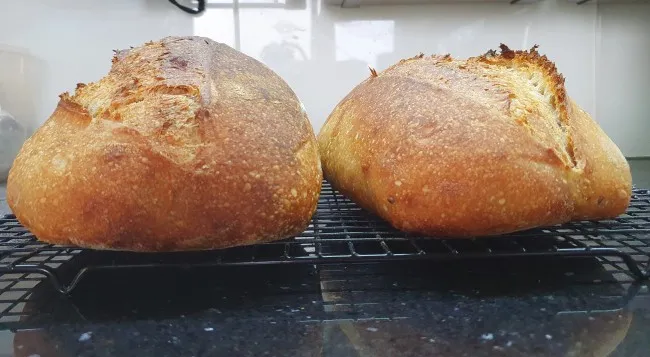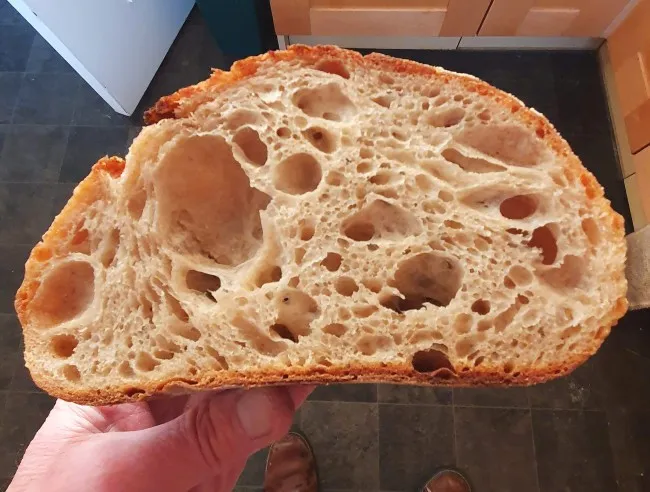My standard sourdough workflow is bulk ferment/scale/bench rest/shape/ambient proof/retard/bake.
The question is how much ambient proof? Many do none. I have been dabbling with some, based on aliquot jar measurements.
So I did a little experiment and took a dough that had had 20% bulk increase. Then I set up the aliquot jar for the bench rest and ambient proof. One loaf got 25% increase in about 1 hour and the other loaf got 50% over about 1hr 40min.
When baked there was an obvious difference in height between the two loaves:

The loaf on the left had a height of 102mm and the one on the right had a height of 90mm - quite a difference.
The loaf on the left was the one with the shorter ambient proof. I guess the next step would be to compare zero ambient proof with the 25% AP. I might run this as a future experiment, but at least in this instance, the 25% figure looks good.
Crumb shot of taller (left hand) loaf:

And crumb shot of the not so tall (right hand) loaf:

Some bake details:
- PFF 10%
- Flour excl levain 12.5% Emmer, 7.5% Rye, 1% malt, rest BF
- Hydration 77%
- Bulk temp 25C
- Bulk time 2hrs 40min
- Ambient temp for pre-retard AP 25C
Lance
Lance if possible, please post crumb shots.
How much PFF?
Type of flour?
Ambient temp?
Experiments like this are indicating that the long fermentation times and high rise percentages may not be needed. And, may even be detrimental. If this turns out to be the case, those wanting long fermentation times may need to reduce the PFF and/or lower the ambient temp.
I assume you are using your typical SD starter and not LM.
Thanks for posting your experiment.
Yes I’d love to see the crumb as well. Do you think that the shorter loaf with less rise ended up overproofed?
Benny
I've only cut into one loaf so far and that is the taller one. I'll add a shot to the original post with some bake details.
I'll include the other crumb shot next week.
It certainly looks like the the longer AP of the flatter loaf caused it to be overproofed. Quite surprising when you consider that bulk was only 20%. Thereagain, my fridge temp was probably about 6C so that will have had a bearing.
Lance
I've edited my original post to show the crumb of the loaf with the longer pre-retard ambient proof.
As you can see, it's nothing like as wild as the shorter ap version. It does maybe have a bit more flavour to it though, but flavour of both was good - the emmer and rye were both freshly milled, which probably helped.
Lance
Lance, different strokes for different folks. For me the smaller loaf gets the gold metal. I would say that it has open and uniform crumb. Since the “big hole craze”, I think the words open crumb took on a new meaning. The slice shows no sign of density and it will hold the condiments.
Your experiment shows the affects of duration of fermentation quite clearly.
Thanks for posting,
Danny
I agree with Dan, I prefer the crumb of the second loaf to the crumb of the first. The more even crumb is far more practical for sandwiches or toppings.
as well ?. In most cases it just a better eating experience. When the bread is eaten dipped in olive oil or a vinaigrette the open crumb is fine but making a sandwich that needs to hold the toppings a nice even crumb is hard to beat.